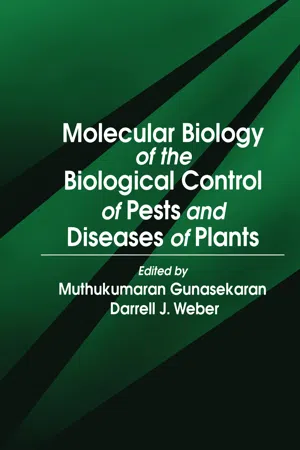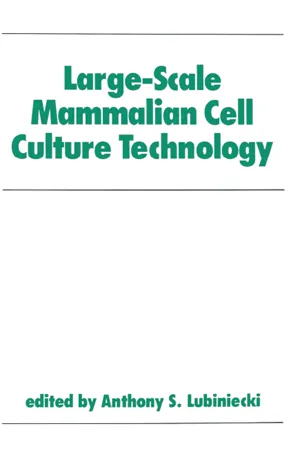Baculovirus
Baculovirus is a type of virus that infects insects, particularly caterpillars. It is widely used in biotechnology as a vector for gene expression in insect cells. Baculoviruses have a unique life cycle, with two distinct forms: occlusion-derived virus (ODV) and budded virus (BV). They are of interest for their potential applications in pest control and as tools for protein production.
6 Key excerpts on "Baculovirus"
- eBook - ePub
- Boriana Marintcheva(Author)
- 2017(Publication Date)
- Academic Press(Publisher)
...As infection progresses, cells start producing massive amounts of BV and ODV, lyse and release occlusion bodies, which get deposited on leaves upon the larvae disintegration. Image courtesy Clem RJ, Passarelli AL. Baculoviruses: sophisticated pathogens of insects. PLoS Pathog 2013; 9 (11):e1003729. https://doi.org/10.1371/journal.ppat.1003729, CC-BY, https://creativecommons.org/licenses/by/4.0/. Figure 7.6 Stages on baculivirus infection in Helicoverpa armigera (cotton bollworm) larvae. Helicoverpa armigera is a moth whose larvae feed on a wide range of plants, including many agriculturally significant species. (A) wild type control; (B) dead larvae hanging in a signature wilt pose; (C) dead larvae with ruptured cuticle releasing cellular lysate rich with Baculovirus occlusion bodies; (D) Baculovirus occlusion bodies at ×400 magnification. Reprinted from Grzywacz D. Basic and applied research: Baculovirus. In: Lacey, Lawrence A, editors. Microbial control of insect and mite pests. Academic Press; 2017. p. 27–46, with permission from Elsevier. Advantages of Baculoviruses as bioinsecticides include: (1) safety driven from narrow host range; (2) compatibility with various modes of manufacturing (air-drying, spray-drying or freeze-drying) and applications (spray, suspensions, powder, granules, stickers, etc.); and (3) stability at ambient temperature allowing long-term storage. Current hurdles preventing widespread use include: (1) slow rate of insect killing in comparison to chemical insecticides; (2) need for repeated application due to UV damage; and (3) high cost due to lack of infrastructure for large-scale production. Research efforts in various direction aim to solve these issues in an attempt to develop cost-effective large-scale manufacturing...
- B. D. Kaushik, Deepak Kumar, Md. Shamim, B. D. Kaushik, Deepak Kumar, Md. Shamim(Authors)
- 2019(Publication Date)
- Apple Academic Press(Publisher)
...Researchers are trying to use genetic engineering techniques to solve this problem. 4.2.1.1 Appearance Baculovirus killed insects have a distinctive shiny-oily appearance, are extremely delicate (may rupture to release fluid filled with infective virus particles), and are often seen hanging limply from vegetation. The attachment to foliage and rupturing on touch is very important in order to continue the virus-life cycle of infecting and replicating, as only then can they be consumed by healthy caterpillars. Unlike other viruses, most Baculoviruses can be easily seen with a light microscope with their polyhedral looking like clear, irregular crystals of salt, or sand when viewed at 400× or 1000× magnification. 4.2.1.2 Baculovirus Diversity Baculoviruses have varied applications like from being used as a biopesticide in agriculture and forestry to being used as expression vectors in biotechnology. Baculoviruses are pathogenic to arthropods—predominantly holometabolous insects. Among the two generas of Baculoviridae (Van Regenmortel et al., 2000), NPV have virions embedded in a crystalline matrix of the protein polyhedron that vary in their configurations of enveloping nucleocapsids singly or in multiples (the occluded viruses are referred to as polyhedral) while the granuloviruses (GV) have one, or rarely two, virions embedded in a crystalline matrix of granulin with their nucleocapsid singly enveloped. This virus has been used as a lethal weapon in their natural form against numerous notorious insect pests (Moscardi, 1999). The Baculoviruses strain isolated from Lepidoptera which are the primary source where they have been isolated, only cause mortality in the larval stage (Cory, 2000). To initiate infection this viruses need to be ingested by the larvae...
- eBook - ePub
Integrated Pest Management
Current Concepts and Ecological Perspective
- Dharam P Abrol(Author)
- 2013(Publication Date)
- Academic Press(Publisher)
...The DNA–protein complex is contained by a rod-shaped nucleocapsid comprising a 39 kDa or 87 kDa capsid protein (King et al., 1994). The size of the virus genome determines the length of the nucleocapsid, which may be 200–400 nm. The width remains constant at about 36 nm. Polyhedra consist largely of a single protein (polyhedrin) of about 30 kDa and formed in the nucleus of infected cells. Virions that have been released from polyhedra are called polyhedra-derived virus in the midgut tissues of susceptible insects, whereas virions that are released from cells without occlusion are called extracellular viruses (ECV) or budded viruses. On the other hand, GVs contain one virion (singly enveloped nucleocapsid) per virus occlusion body or granule. Granulin, the major granule protein, is similar to polyhedrin in function. The Baculovirus life cycle involves two distinct forms of virus: i. Occlusion/Polyhedra-Derived virus (ODV/PDV) is present in a protein matrix (polyhedrin or granulin) and is responsible for the primary infection in the midgut epithelial cells of the host. ii. Budded virus (BV) is the non-occluded form released from the infected host cells later during the secondary infection. 12.3 Use of Entomopathogenic Bacteria and Viruses as Biocontrol Agents Entomopathogenic bacteria, like other natural enemies, can exert considerable control of target populations (Lacey et al., 2001). In nature, occurrence of natural epizootics of viral, bacterial and fungal pathogens may be held responsible for the decline in insect-pest populations (Evans, 1986 ; McCoy et al., 1988). Among the bacterial pathogens, Bt is the most studied and exploited one. Bacillus thuringiensis (Bt) is a spore forming bacterium, with its sporulation generally associated with the synthesis of a proteinaceous protoxin crystal that has insecticidal activities. It has been used for the control of lepidopteran, dipteran and coleopteran insects for over three decades (Sarvjeet, 2000)...
- Muthukumaran Gunasekaran, Darrell Jack Weber(Authors)
- 2020(Publication Date)
- CRC Press(Publisher)
...6 Genetically Enhanced Baculovirus Insecticides H. Alan Wood TABLE OF CONTENTS I. Introduction II. Pesticidal Gene Constructs A. Diuretic Hormone B. Juvenile Hormone Esterase C. ECDYSTEROID UDP-GLUCOSYL TRANSFERASE D. Scorpion Toxin E. Straw Itch Mite Toxin F. Bt Toxin G. Maize Mitochondria Factor III. Environmental Concerns IV. Field Testing of Recombinant Baculoviruses A. Marked Virus Release B. polyhedrin-MINUS VIRUS C. Co-Occluded Virus Release D. Pre-Occluded Virus Release E. AaIT Virus Release V. Summary References I. Introduction Baculoviruses are DNA viruses and comprise the largest and most widely studied group of viruses that are pathogenic to insects. The majority of Baculoviruses have been reported from species in the order Lepidoptera, many of which are major agricultural or forest pests. 1 For over a hundred years, naturally occurring Baculovirus epizootics have been recognized as having the capacity in nature to regulate insect pest populations. Based on these observations, biological control programs have attempted to create artificial viral epizootics prior to the development of pest populations above economic thresholds. 2 It was considered that these viruses could serve as safe and effective alternatives to chemical insecticides. This approach has proven very successful in Brazil for the control of Anticarsia gemmatalis in over 2 million acres of soybean fields, using the A. gemmatalis nuclear polyhedrosis virus (AgMNPV). 3 However, the use of Baculoviruses as alternatives to chemical insecticides has generally been problematic for several reasons. First and foremost, the production costs of viral pesticides in most countries have been significantly higher than cost of chemical pesticides...
- eBook - ePub
- Anthony S. Lubiniecki(Author)
- 2018(Publication Date)
- Routledge(Publisher)
...Cell Biol. 3: 2156–2165 (1983). 13. Luckow, V.A. and Summers, M.D.Trends in the development of Baculovirus expression vectors. Biotechnology 6: 47–55 (1988). 14. Hink, W.F. and Bezanson, D.R.Invertebrate cell culture media and cell lines. In Techniques in the Life Sciences, Vol. C1, Techniques in Setting Up and Maintenance of Tissue and Cell Cultures (E.Kurstak, ed.), Elsevier, New York, pp. C111/1-C111/30 (1985). 15. Grace, T.D.C.Establishment of four strains of cells from insect tissues grown in vitro. Nature 195: 788–789 (1962). 16. Bilimoria, S.L. and Sohi, S.S.Development of an attached strain from a continuous insect cell line. In Vitro 13: 461–466 (1977). 17. Lynn, D.E. and Hink, W. F.Comparison of nuclear polyhedrosis virus replication in five lepidopteran cell lines. J. Invertebr. Pathol. 35: 234–240 (1980). 18. McIntosh, A.H., Ignoffo, C.M., and Andrews, P.L.In vitro host range of five Baculoviruses in lepidoteran cell lines. Intervirology 23: 150–156 (1985). 19. Goodwin, R.H., Tompkins, G.J., and McCawley, P.Gypsy moth cell lines divergent in viral susceptibility. I. Culture and Identification. In Vitro 14: 485–494 (1978). 20. McIntosh, A.H. and Ignoffo, C.M.Replication and infectivity of the single-embedded nuclear polyhedrosis virus, Baculovirus heliothis, in homologous cell lines. J. Invertebr. Pathol. 37: 258–264 (1981). 21. Sohi, S.S., Percy, J., Cunningham, J.C., and Arif, B.M.Replication and serial passage of a multicapsid nuclear polyhedrosis virus of Orgyia pseudotsugata (Lepidoptera: Lymantriidae) in continuous insect cell lines. Can. J. Microbiol. 27: 1133–1139 (1981). 22. Sohi, S.S., Percy, J., Arif, B.M., and Cunningham, J.C.Replication and serial passage of a single enveloped Baculovirus of Orgyia leucostigma in homolgous cell lines. Intervirology 21: 50–60 (1984). 23. Volkman, L.E. and Goldsmith, P.A.Generalized immunoassay for Autographa californica nuclear polyhedrosis virus infectivity in vitro. Appl. Environm. Microbiol...
- eBook - ePub
- David P. Clark(Author)
- 2009(Publication Date)
- Academic Cell(Publisher)
...However, the head of T4 is relatively elongated in order to accommodate the much greater amount of DNA. Attached to the head is a tail with tail fibers that act as landing legs. These viruses bind to bacterial cells by means of recognition proteins on the end of their tail fibers. After setting down like lunar landers, their tails contract and they inject their DNA like miniature hypodermic syringes. bacteriophage M13 A small male-specific filamentous virus that contains circular single-stranded DNA and infects Escherichia coli male-specific phage Virus that only infects “male” bacteria, i.e., those bacteria carrying the F-plasmid DNA Viruses of Higher Organisms Most DNA viruses of animals contain double stranded DNA. For example, Simian Virus 40 (SV40) is a smallish, spherical virus that causes cancer in monkeys by inserting its DNA into the host chromosome. Another double stranded DNA virus, Herpes virus, is spherical with an extra outer envelope of material stolen from the nuclear membrane of the host cell (Fig. 17.14). The internal nucleic acid with its protein shell is referred to as the nucleocapsid. This family includes viruses that cause cold sores and genital herpes as well as chickenpox and infectious mononucleosis. The herpes viruses are difficult to cure completely as they are capable of remaining in a latent state where they cause no damage but merely replicate in step with the host cell. Active infections may then break out again after a long period of quiescence, due to stress or other factors. Figure 17.14 Herpes Viruses and Pox Viruses Many animal viruses use dsDNA for their genomes. The Herpesvirus is a simple virus that has a protein coat and outer envelope surrounding the double-stranded DNA genome. The Poxvirus has two envelope layers. A protein layer, known as the palisade, is embedded within the core envelope. In addition, pre-made viral enzymes are also packaged with the genome to allow replication immediately upon infection...





